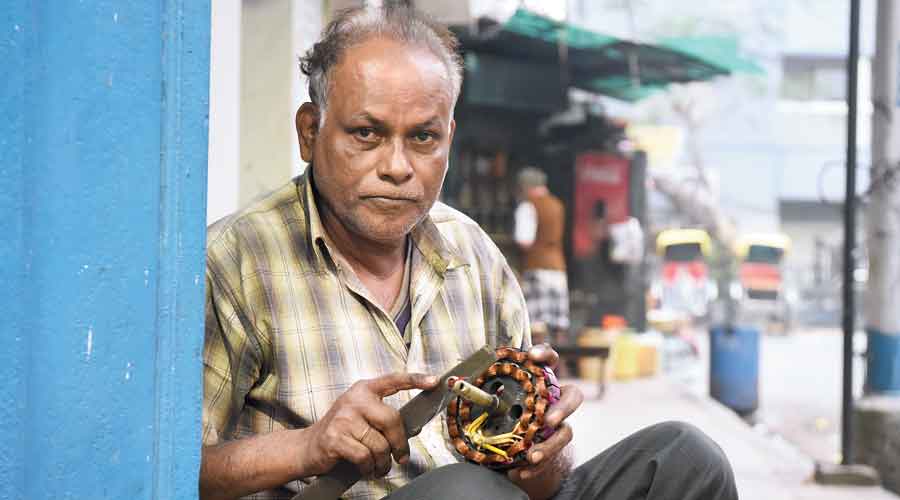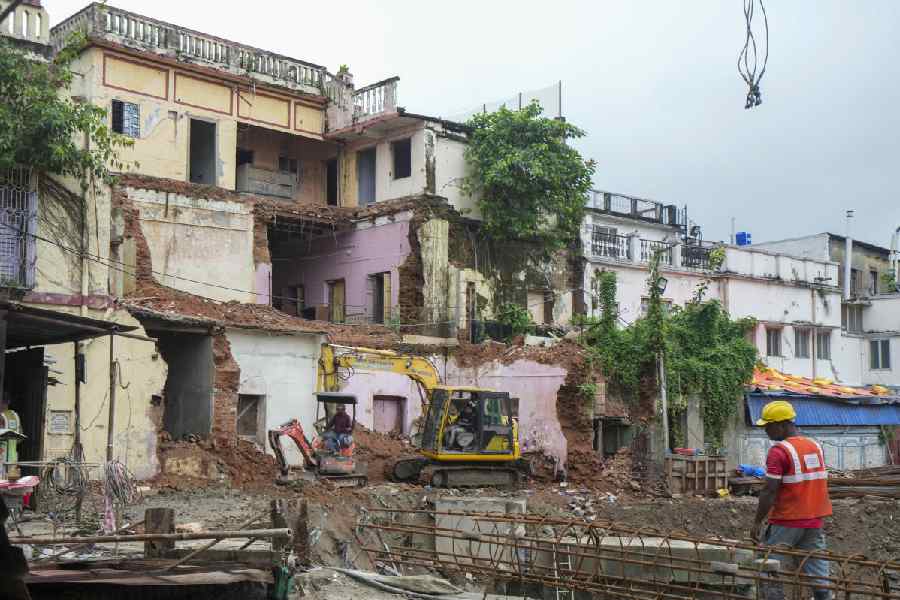Buildings are like people. They have distinct personalities; some even have faces. Some of them age well, some of them do not. In any case, they need care.
Especially their wiring. If the analogy is stretched further, the wiring can be said to run through the buildings like veins through a human body. Wires weaken, rupture, cause blackouts. In an old building, they are more prone to damage.
Then Sunil Kumar Jana is called in. Jana, 54, is the go-to electrician for some residents of Ballygunge Place, the elite south Calcutta neighbourhood, still full of old buildings, though they are disappearing fast. A quiet, dignified man who does not like to waste his words, Jana has been working in Ballygunge Place for 28 years. As a family doctor knows the pulse of his patient, Jana knows where exactly to tap the wiring of a building for something that has gone wrong. A joint may need to be seen. A wire may have come loose. The bodies of old buildings need constant attention. “Wires have a certain life span,” reminds Jana. “In this area much of the wiring is 60 or even 70 years old.”
He looks trained in an ancient craft as from the height of a ladder in an old building he unfastens an old glass lampshade hanging from an iron stem, an activity that often requires a knowledge of complex fittings, the mysteries of which a new-age electrician may not want to get into. Jana also offers to clean the lampshades and the fans. He knows the power of the bulb required for a particular lampshade at a particular house or which fan just needs a gentle nudge with a jhuljhara to start rotating again. He also warns against keeping the AC main switch turned on; it keeps the electricity operating. He does not have a helper, because he is not certain how he will behave when allowed entry into the most private parts of a house. He starts working from 9am and works till he is required to. House-owners wonder what will happen once he retires.
Jana himself lives at the back of a well-known Ballygunge Place sweet shop, adjacent to his own shop in the ground floor of a building. But Jana’s shop is actually a narrow glass case with wooden doors attached to the wall next to the sweet shop. His tools rest on the shelves. A signboard saying Rakhesh Electronics hangs over the glasscase. Rakhesh is his son’s name.
Jana did not arrive at this affluent locality because he wanted to. Neither did he want to become an electrician. Life has just delivered him here.
He was born in Ekabbarpur village under Jagatballavpur police station area in Howrah. He studied till Class IV. He had seven siblings. His father was a farmer who did not earn enough for his large family. When Jana was about 12, in the late 70s, he came over to Calcutta to work at Sutripti, another well-known sweet shop, located in Rashbehari Avenue, near Cornfield Road. There he worked as a table boy. A few years later the shop closed down because of differences between the owner and the employees’ union.
Jana found work at a small shop in Behala near a masjid for the next eight to 10 years, selling tea, ghughni and small snacks. But he had to leave the place. The next year he was jobless. Back home in Howrah, where his wife, son and daughter still live, he then had to often survive on bulgar.
In that desperate state he came over to Calcutta again and trained as an electrician at a store in Amherst Street. He was a “helper” at first. This was in the late 80s. But he was earning very little — Rs 10 every week.
He left for a tea garden in Assam’s Dibrugarh, where he worked at the tea factory for 18 months, which paid more. Then on the recommendation of a relative, he came over to Ballygunge Place, and stayed on.
Through these years, he has been witness to many changes. Homes have transitioned from the trembling glow of “light bulbs” to the white haze of “tube lights” (fluorescent lights) to the steady glares of CFLs and LEDs. Jana’s work has changed with each shift.
“Previously I would be called in a lot to fix the bulbs and ‘tube lights’. ‘Tubes’ would have chokes, starters, holders. These would cause trouble. LEDs last much longer, consume less electricity,” he said.
He is called in less. But newer fans make up for this. “Old fans are heavier and have 700/800 grams of coils inside them. New fans are lighter and contain about 250 grams of coils. They heat up.”
The problems created by new fans keep Jana busy a lot during summer.
The bigger change has been the buildings themselves. Jana has watched from close the demolition of the old buildings and the advent of the new ones, mostly apartment blocks. New houses altogether require an electrician less. Their dimensions keep everything within reach. Or there are gadgets. “Even chandeliers are remote-controlled,” Jana said.
The people have changed. “Earlier, I would even be asked to have a meal at some homes after my work. I was treated with more respect, more kindness,” Jana said.
His knowledge, too, does not extend to the new age. He only knows how to fix the electrical problems of a household. “I cannot repair a microwave, washing machine or fridge. I can only repair a mixie,” he said.
He will keep working till he can, Jana said. But he cannot stop the houses around him from retiring.











